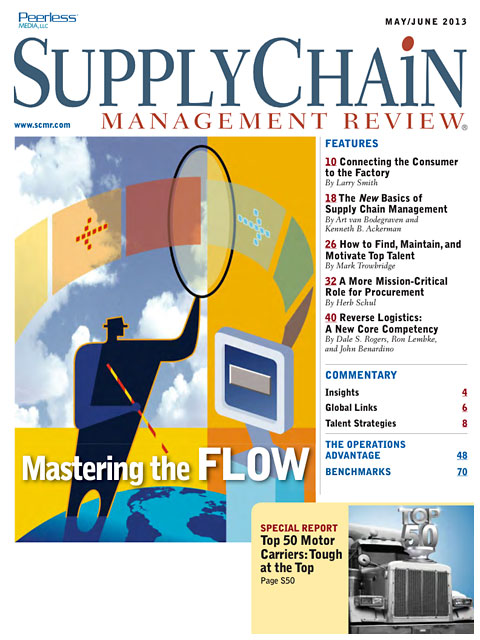Sorry, but your login has failed. Please recheck your login information and resubmit. If your subscription has expired, renew here.
May-June 2013
While supply chain planning based on end-user demand has been applied in the B2B arena for decades, it is only now becoming practical in retail channels. But as distribution resource planning tools and techniques emerge, trading partners can now coordinate their supply chain as if only one company were managing it—effectively connecting the consumer to the factory. Browse this issue archive.Need Help? Contact customer service 847-559-7581 More options
Managing product that does not sell, is entering the end of its life, or has been returned due to buyer’s remorse is now generally understood to be a critical part of product life cycle management. Yet this has not always been the case. Historically, most of the attention paid to product management has focused on the introductory phase or on the volume-shipping portion of the product life cycle. The leaders have greatly broadened this perspective. They know that the difference between a product’s success (and profitability) and failure often depends on how the end of life is managed.
The leaders understand, too, the business importance of taking good care of consumers. They know that customer satisfaction holds the key to long-term success and that enabling them to return products without penalty is a big part of the equation. The practice of customer returns isn’t really new (see accompanying sidebar “Sears and JC Penney—Pioneers of Customer Returns,”on page 42), but it has become much more cost-efficient in the top-performing companies.
This article strives to make the case for building an effective reverse logistics program in your organization. It describes the importance of this key component of supply chain management and outlines how reverse logistics differs from forward logistics. We then describe some of the key considerations in building a reverse logistics competency and then list key metrics that need to be put in place. Finally, the article offers some practical steps that readers can take to build momentum for a successful reverse logistics program in their organization.
 |
This complete article is available to subscribers
only. Click on Log In Now at the top of this article for full access. Or, Start your PLUS+ subscription for instant access. |
Not ready to subscribe, but need this article?
Buy the complete article now. Only $20.00. Instant PDF Download.
Access the complete issue of Supply Chain Management Review magazine featuring
this article including every word, chart and table exactly as it appeared in the magazine.
SC
MR
Sorry, but your login has failed. Please recheck your login information and resubmit. If your subscription has expired, renew here.
May-June 2013
While supply chain planning based on end-user demand has been applied in the B2B arena for decades, it is only now becoming practical in retail channels. But as distribution resource planning tools and techniques… Browse this issue archive. Access your online digital edition. Download a PDF file of the May-June 2013 issue. |
Download Article PDF |
Managing product that does not sell, is entering the end of its life, or has been returned due to buyer’s remorse is now generally understood to be a critical part of product life cycle management. Yet this has not always been the case. Historically, most of the attention paid to product management has focused on the introductory phase or on the volume-shipping portion of the product life cycle. The leaders have greatly broadened this perspective. They know that the difference between a product’s success (and profitability) and failure often depends on how the end of life is managed.
The leaders understand, too, the business importance of taking good care of consumers. They know that customer satisfaction holds the key to long-term success and that enabling them to return products without penalty is a big part of the equation. The practice of customer returns isn’t really new (see accompanying sidebar “Sears and JC Penney—Pioneers of Customer Returns,”on page 42), but it has become much more cost-efficient in the top-performing companies.
This article strives to make the case for building an effective reverse logistics program in your organization. It describes the importance of this key component of supply chain management and outlines how reverse logistics differs from forward logistics. We then describe some of the key considerations in building a reverse logistics competency and then list key metrics that need to be put in place. Finally, the article offers some practical steps that readers can take to build momentum for a successful reverse logistics program in their organization.
 |
SUBSCRIBERS: Click here to download PDF of the full article. |
SC
MR


Latest Supply Chain News
- Three frameworks for creative problem-solving in supply chain
- Mitigating geopolitical uncertainty: 4 essential tactics for industrial CSCOs
- Supply chain strategy for medical devices: A Q&A with industry expert Sanjay Gupta
- Inventory Management and the Supply Chain: Outlook 2025
- How technological innovation is paving the way for a carbon-free future in logistics and supply chains
- More News
Latest Podcast

 Explore
Explore
Topics
Latest Supply Chain News
- Three frameworks for creative problem-solving in supply chain
- Mitigating geopolitical uncertainty: 4 essential tactics for industrial CSCOs
- Supply chain strategy for medical devices: A Q&A with industry expert Sanjay Gupta
- Inventory Management and the Supply Chain: Outlook 2025
- How technological innovation is paving the way for a carbon-free future in logistics and supply chains
- Parcel shipping spend: The untamed holdout in today’s supply chains
- More latest news
Latest Resources

Subscribe

Supply Chain Management Review delivers the best industry content.

Editors’ Picks





